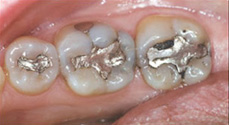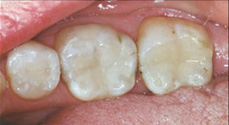Composite tooth-coloured fillings vs. Silver fillings
Composite(or white) filling material is used more commonly used today as the materials have improved significantly in strength over the last several years. This filling material is the most commonly used in our practice today. Composite fillings are made of a hard resin or (plastic) material that moulds inside the tooth and is set or hardens by directing an ultra-violet light at the material.
There are advantages to using the tooth-coloured filling materials:
- The filling material will bond directly to the tooth surface
-
Less tooth structure is removed to place them
- They will not discolor the natural enamel
- They match the color of your natural tooth
Silver filling or “amalgam” materials are used less today for several reasons:
- They do not bond directly to the tooth surface
- Placement of silver filling material requires removal of more tooth structure
- As they get older they will lose the seal with the tooth and the margins around the filling will breakdown and the filling will start to leak
- Leaking fillings can cause the tooth to discolor or darken and the bacteria can accumulate under the filling causing more “recurrent decay” – or what is known as a new cavity
- Silver fillings can also expand as they age causing pressure and stress lines on the natural tooth – these areas can fracture if the filling is not replaced
Old(er) Silver Fillings
Composite tooth-coloured fillings vs. Silver fillings
Composite(or white) filling material is used more commonly used today as the materials have improved significantly in strength over the last several years. This filling material is the most commonly used in our practice today. Composite fillings are made of a hard resin or (plastic) material that moulds inside the tooth and is set or hardens by directing an ultra-violet light at the material.
There are advantages to using the tooth-coloured filling materials:
- The filling material will bond directly to the tooth surface
-
Less tooth structure is removed to place them
- They will not discolor the natural enamel
- They match the color of your natural tooth
Silver filling or “amalgam” materials are used less today for several reasons:
- They do not bond directly to the tooth surface
- Placement of silver filling material requires removal of more tooth structure
- As they get older they will lose the seal with the tooth and the margins around the filling will breakdown and the filling will start to leak
- Leaking fillings can cause the tooth to discolor or darken and the bacteria can accumulate under the filling causing more “recurrent decay” – or what is known as a new cavity
- Silver fillings can also expand as they age causing pressure and stress lines on the natural tooth – these areas can fracture if the filling is not replaced


